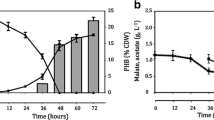Abstract.
The effect of glucose and glucose analogs on the amount of rbcS transcript and on metabolism was investigated in autotrophic cell-suspension cultures of Chenopodiumrubrum L. Within 10 h glucose led to a decrease of the transcript for rbcS, and an increase of phosphorylated metabolites and carbohydrates. The changes of transcript and metabolism showed the same concentration dependence, and were already marked at 1 mM glucose. Mannose at 10 mM led to a decrease of rbcS transcript, a decrease of phosphorylated intermediates, and an inhibition of photosynthesis. [14C] Mannose was slowly metabolised to anions and cations. Very low concentrations (0.2 mM) of 2-deoxyglucose (2DOG) led to a decrease of rbcS transcript within 6 h, a large depletion of phosphorylated intermediates, ATP and UDPglucose, and an inhibition of photosynthesis. The changes of metabolism and photosynthesis were not reversed by phosphate. There was a gradual recovery of rbcS transcript after 24–36 h, which occurred earlier and was larger than the recovery of metabolites or photosynthesis. When 14C-labelled 2DOG was supplied at 0.2 mM to investigate 2DOG uptake and metabolism during this transient repression of rbcS expression, net uptake and net phosphorylation of 2DOG stopped after 4 and 6 h, respectively, even though considerable amounts of 2DOG were still present in the medium and the cells. Of the 2DOG entering the cells, over 70% was metabolised in the first 6 h. Unexpectedly, only 20% remained in 2DOG-6-phosphate, and 30–35% was converted to 2-deoxysucrose. At later time points, label in 2DOG decreased, in parallel with a decrease of label in 2DOG-6-phosphate, and in 2DOG in the cells. Label accumulated in unidentified acidic compounds, in three further low-molecular-weight neutral compounds, and in insoluble compounds. To investigate why net uptake and phosphorylation of 2DOG was inhibited, cells were preincubated with 0.2 mM 2DOG for 24 h, and then supplied with [14C]2DOG or [14C]glucose. Preincubation with 2DOG led to a small (about 50%) inhibition of [14C]2DOG uptake and phosphorylation (indicating that there is recycling of 2DOG), and a strong inhibition of deoxysucrose (85%) and sucrose (50%) synthesis from [14C]2DOG and [14C]glucose, respectively. The implications of these results for the interpretation of experiments with 2DOG are discussed.
Similar content being viewed by others
Author information
Authors and Affiliations
Additional information
Received: 23 June 1997 / Accepted: 26 September 1997
Rights and permissions
About this article
Cite this article
Klein, D., Stitt, M. Effects of 2-deoxyglucose on the expression of rbcS and the metabolism of Chenopodium rubrum cell-suspension cultures. Planta 205, 223–234 (1998). https://doi.org/10.1007/s004250050315
Issue Date:
DOI: https://doi.org/10.1007/s004250050315




